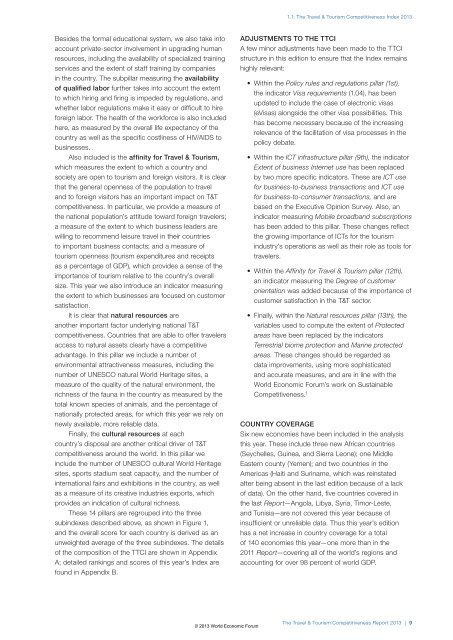The Travel & Tourism Competitiveness Report 2013
The Travel & Tourism Competitiveness Report 2013
The Travel & Tourism Competitiveness Report 2013
You also want an ePaper? Increase the reach of your titles
YUMPU automatically turns print PDFs into web optimized ePapers that Google loves.
Besides the formal educational system, we also take into<br />
account private-sector involvement in upgrading human<br />
resources, including the availability of specialized training<br />
services and the extent of staff training by companies<br />
in the country. <strong>The</strong> subpillar measuring the availability<br />
of qualified labor further takes into account the extent<br />
to which hiring and firing is impeded by regulations, and<br />
whether labor regulations make it easy or difficult to hire<br />
foreign labor. <strong>The</strong> health of the workforce is also included<br />
here, as measured by the overall life expectancy of the<br />
country as well as the specific costliness of HIV/AIDS to<br />
businesses.<br />
Also included is the affinity for <strong>Travel</strong> & <strong>Tourism</strong>,<br />
which measures the extent to which a country and<br />
society are open to tourism and foreign visitors. It is clear<br />
that the general openness of the population to travel<br />
and to foreign visitors has an important impact on T&T<br />
competitiveness. In particular, we provide a measure of<br />
the national population’s attitude toward foreign travelers;<br />
a measure of the extent to which business leaders are<br />
willing to recommend leisure travel in their countries<br />
to important business contacts; and a measure of<br />
tourism openness (tourism expenditures and receipts<br />
as a percentage of GDP), which provides a sense of the<br />
importance of tourism relative to the country’s overall<br />
size. This year we also introduce an indicator measuring<br />
the extent to which businesses are focused on customer<br />
satisfaction.<br />
It is clear that natural resources are<br />
another important factor underlying national T&T<br />
competitiveness. Countries that are able to offer travelers<br />
access to natural assets clearly have a competitive<br />
advantage. In this pillar we include a number of<br />
environmental attractiveness measures, including the<br />
number of UNESCO natural World Heritage sites, a<br />
measure of the quality of the natural environment, the<br />
richness of the fauna in the country as measured by the<br />
total known species of animals, and the percentage of<br />
nationally protected areas, for which this year we rely on<br />
newly available, more reliable data.<br />
Finally, the cultural resources at each<br />
country’s disposal are another critical driver of T&T<br />
competitiveness around the world. In this pillar we<br />
include the number of UNESCO cultural World Heritage<br />
sites, sports stadium seat capacity, and the number of<br />
international fairs and exhibitions in the country, as well<br />
as a measure of its creative industries exports, which<br />
provides an indication of cultural richness.<br />
<strong>The</strong>se 14 pillars are regrouped into the three<br />
subindexes described above, as shown in Figure 1,<br />
and the overall score for each country is derived as an<br />
unweighted average of the three subindexes. <strong>The</strong> details<br />
of the composition of the TTCI are shown in Appendix<br />
A; detailed rankings and scores of this year’s Index are<br />
found in Appendix B.<br />
© <strong>2013</strong> World Economic Forum<br />
1.1: <strong>The</strong> <strong>Travel</strong> & <strong>Tourism</strong> <strong>Competitiveness</strong> Index <strong>2013</strong><br />
ADJUSTMENTS TO THE TTCI<br />
A few minor adjustments have been made to the TTCI<br />
structure in this edition to ensure that the Index remains<br />
highly relevant:<br />
• Within the Policy rules and regulations pillar (1st),<br />
the indicator Visa requirements (1.04), has been<br />
updated to include the case of electronic visas<br />
(eVisas) alongside the other visa possibilities. This<br />
has become necessary because of the increasing<br />
relevance of the facilitation of visa processes in the<br />
policy debate.<br />
• Within the ICT infrastructure pillar (9th), the indicator<br />
Extent of business Internet use has been replaced<br />
by two more specific indicators. <strong>The</strong>se are ICT use<br />
for business-to-business transactions and ICT use<br />
for business-to-consumer transactions, and are<br />
based on the Executive Opinion Survey. Also, an<br />
indicator measuring Mobile broadband subscriptions<br />
has been added to this pillar. <strong>The</strong>se changes reflect<br />
the growing importance of ICTs for the tourism<br />
industry’s operations as well as their role as tools for<br />
travelers.<br />
• Within the Affinity for <strong>Travel</strong> & <strong>Tourism</strong> pillar (12th),<br />
an indicator measuring the Degree of customer<br />
orientation was added because of the importance of<br />
customer satisfaction in the T&T sector.<br />
• Finally, within the Natural resources pillar (13th), the<br />
variables used to compute the extent of Protected<br />
areas have been replaced by the indicators<br />
Terrestrial biome protection and Marine protected<br />
areas. <strong>The</strong>se changes should be regarded as<br />
data improvements, using more sophisticated<br />
and accurate measures, and are in line with the<br />
World Economic Forum’s work on Sustainable<br />
<strong>Competitiveness</strong>. 1<br />
COUNTRY COVERAGE<br />
Six new economies have been included in the analysis<br />
this year. <strong>The</strong>se include three new African countries<br />
(Seychelles, Guinea, and Sierra Leone); one Middle<br />
Eastern county (Yemen); and two countries in the<br />
Americas (Haiti and Suriname, which was reinstated<br />
after being absent in the last edition because of a lack<br />
of data). On the other hand, five countries covered in<br />
the last <strong>Report</strong>—Angola, Libya, Syria, Timor-Leste,<br />
and Tunisia—are not covered this year because of<br />
insufficient or unreliable data. Thus this year’s edition<br />
has a net increase in country coverage for a total<br />
of 140 economies this year—one more than in the<br />
2011 <strong>Report</strong>—covering all of the world’s regions and<br />
accounting for over 98 percent of world GDP.<br />
<strong>The</strong> <strong>Travel</strong> & <strong>Tourism</strong> <strong>Competitiveness</strong> <strong>Report</strong> <strong>2013</strong> | 9

















